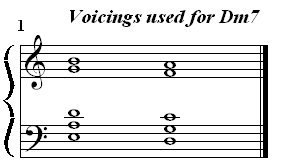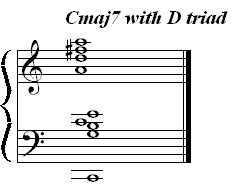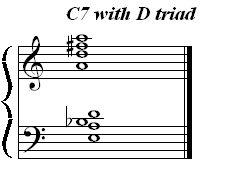| A Systematic Approach To Jazzpiano Voicings | by Christiaan 'Niliov' van Hemert | ||||||||||||||||||||||||||||||||||||||||||||||||||||||||||||||||||||
|
Over the years a lot of people have asked me about my voicings. I usually end up writing down my system. Just recently a friend suggested to make a homepage on this subject to save time. To fully comprehend the contents of this page you should be familiar with basic jazz harmony and theory. If you don't know anything about chords or can't figure out chord symbols first study: Chords and What To Make Of Them. Voicings can be devided into two groups:
Root voicings. Personally I prefer rootless voicings, but I believe that one should be familiar with root voicings. Root voicings are actually very simple, let's start with a | I-VI | II-V | I | in Bb(7), a common turnaround, for example in a Bb blues: This is also available in midi and mpeg3 (61k) 
Notice that the left hand always plays the 1 and 7 or 1 and 3. Let's make a system:
This system is valid for almost any type of chord. Min7b5 chords are debatable. But you can use rootless voicings for these chords. To get fluent in root voicings I believe practicing | I-VI | II-V | I | in all keys with all possible alterations and practicing a rhythm changes bridge in all keys is sufficient. Use different kinds of rhythm changes bridges. Examples: | D7 | % | G7 | % | C7 | % | F7 | % | or | Amin7 | D7 | Dmin7 | G7 | Gmin7 | C7 | Cmin7 | F7 | (also available in midi and mpeg3 (123k)) or | Amin7 | D7 | Gmaj7 | % | Gmin7 | C7 | Fmaj7 | F7 | Of course, there are more possibilities for root voicings but like I said before I prefer rootless voicings. Therefore for me, the above is more than enough. Rootless voicings. Rootless voicings are voicings in which the root is omitted. Therefore these voicings are not suitable for comping without a bass player. I advice you to first practice the left hand. You can use these voicings to comp yourself, while soloing with your right hand. Min7 chords:
Note: b3,5,7,9 doesn't sound good in every inversion (depends on the key): trial and error. Note: the fourths voicing can be shifted 1 step up. For example, So What - Miles Davis, chord used: Dmin7. (midi and mpeg3 (131k)) 
Maj7 chords:
Note: the root position doesn't sound good in every inversion: trial and error. Note: 3,5,maj7,9 doesn't sound good without a bass player. Note: triad in the right hand sounds modern (lydian) (example in midi and mpeg3 (51k)) 
Note: the fourths voicings can be inverted but not shifted. Note: the second fourths voicing sounds more modern. (First voicing is actually 6,9 no maj7) m7b5 Chords:
Sus4 or 7sus(4) Chords: Sus4 chords or 7sus chords can be voiced like the corresponding min7 chords. For example C7sus can be voiced like a Gmin7 and Ab7sus can be voiced like an Ebmin7.
Note: The second sus-voicing is very "heavy" and powerful; McCoy Tyner uses it with great frequency. Experiment with it!! Min6/minMaj7 For these type of chords we don't need another table. Use the mixolydian#11 dominants table: for each min6/minMaj7 chord play the left hand voicing of the corresponding mixo#11 dominant. Some examples will teach you the "trick": Cmin6/CminMaj7 = F7(mixo#11), Abmin6 = Db7(mixo#11), Emin6 = A7 etc. For the right hand you can of course use the same table again, but avoid playing the root of the "according mixo#11 dominant". In other words: if you use a F7(mixo#11) left hand voicing for Cmin6/CminMaj7 don't play a F in the right hand!! Dominant 7: To voice dominant 7 chords one can choose from four different "colors". These colors are often dictated by the chord functions, but I won't go into that on this page. To make things somewhat easier, I will however give you my theoretical rendition of these colors.
Using this handy table, voicing the different colors is an easy matter. Mixolydian #11

Note: The left hand voicings on the second line sound more dissonant. Note: In octave voicings can be the top note omitted -> the voicing will sound less full. Note: The triad voicing should be used with care. (The voicing is very "coercive": the soloist is almost obligated to convey the same sound in his solo). Altered
Note: Again, the left hand voicings from the second line down sound more dissonant. Note: My personal favorite left hand voicings contain a b10 (#9). Note that this isn't really altered tone, but that can be solved by playing the proper alterations in the right hand. Octotonic
Here's a little octotonic "trick". Whereas giving the following voicings in "numbers" would be really difficult and complicated to read, I will give the voicings for D,F,Ab and B octotonic (These voicings will suit all four keys).
Note: These four voicings can be played (and maybe should be played) in succesion going upwards or downwards in reverse (example in midi and mpeg3 (65k)). This example is played with a D in the bass, but it might as well have been a F,Ab or B. This means of course that there are only three possible "sets" of voicings. One for D,F,Ab and B, one for Eb,Gb,A and C and the last one for E,G,Bb and Db. Whole tone
Note: Both the octotonic and especially whole tone sound should be used with taste. Overuse of these sounds can result in very angry soloists. Actually play these sounds when the soloist is suggesting them (In their lines of course).
| |||||||||||||||||||||||||||||||||||||||||||||||||||||||||||||||||||||
